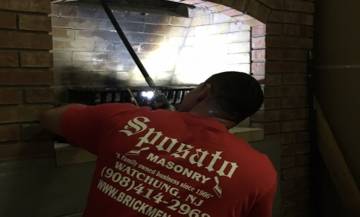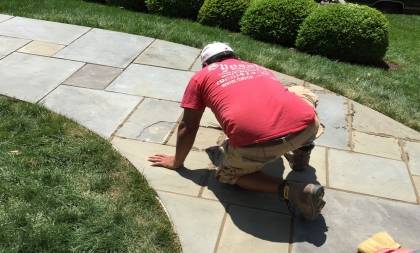
When built properly, retaining walls are an integral part of the house structure that last a lifetime. Retaining walls are can be made from a variety of different materials. A very popular and economical way of installing retaining walls is to use a mortar-less interlocking block system known as gravity walls. These walls have no cement based products incorporated within their construction. Usually, retaining walls sit on a compacted leveled gravel bed with the first course of block below grade. Another rule of thumb is to bury an inch of block per course of wall. These walls are typically very heavy with a lip or pin to interlock each block, and are structured so that each course of wall works with gravity. Once the wall reaches 4 feet in height, a geo grid is required, which is a plastic netting that is sandwiched between the block and goes into the earth 3 feet.
A major reason for failure in the gravity walls is compaction and improper drainage. To relieve water pressure, one cubic foot of gravel should be installed up the back of the wall with a drain pipe at the bottom. Building any type of wall without proper drainage will greatly cut back on the lifespan of the wall.
Using masonry material is another popular method to build a retaining wall. To build these types of walls, a proper concrete footing needs to be installed below the frost line. Usually, 8” or 12” concrete blocks are used to construct the wall. If bricks are being used to face the wall, 12” blocks are usually built up to ground level. 8” concrete blocks are then used from ground level up, which leaves a 4”’ shelf for brick installation. Bricks should be anchored to wall using brick ties. Depending on the height and type of dirt in the area, rebar is installed in the cores of the blocks and runs down to the footing. It is then filled solid with 3/8 of concrete mix, which creates columns though the wall.
For this method, it is also very important to install a proper drainage bed. It is placed behind the walls to relive water pressure and prevent efflorescence. Efflorescence is a chemical reactant caused by water reacting with the cement, which creates salt crystals that are pushed up to the surface. This causes an unseemly white film on the surface and it is very difficult to remove. If the installer understands all the key factors in installing a retaining wall, you should have a structurally sound wall that will last a lifetime.

Chimney Repair

Chimney Cleaning

Bluestone Work

Brickwork

Basement & Waterproofing

